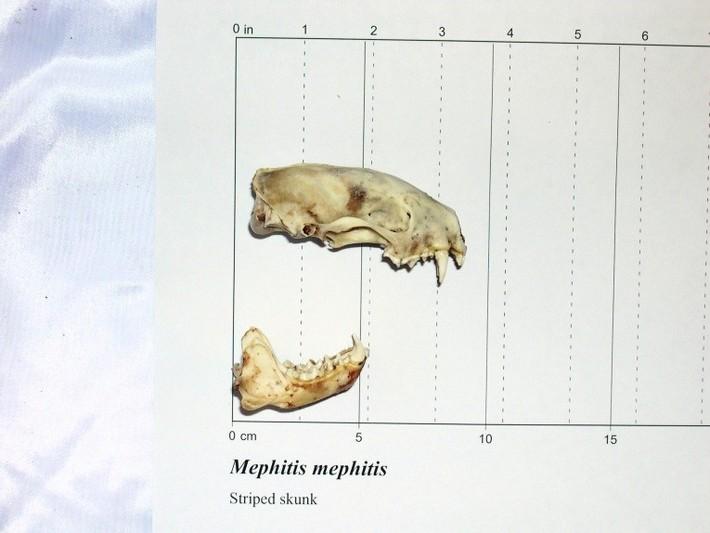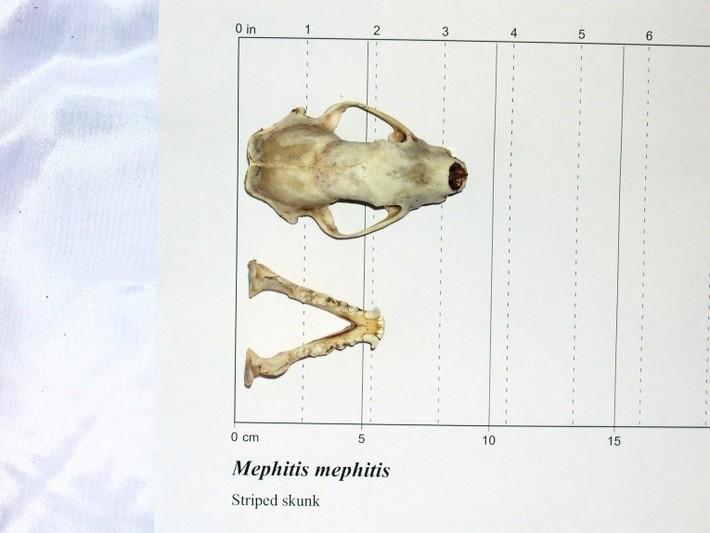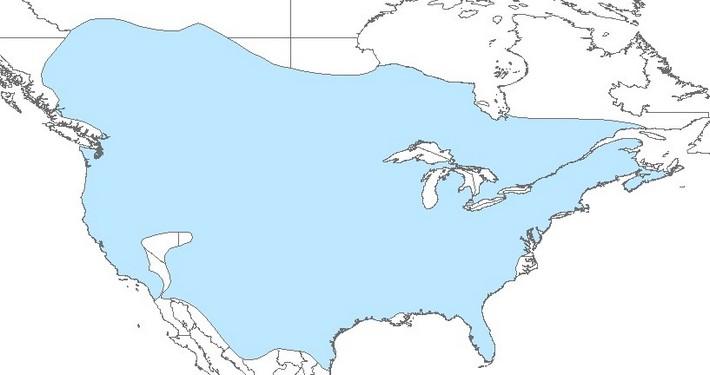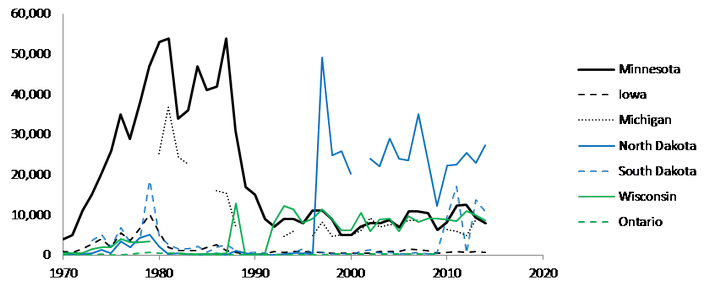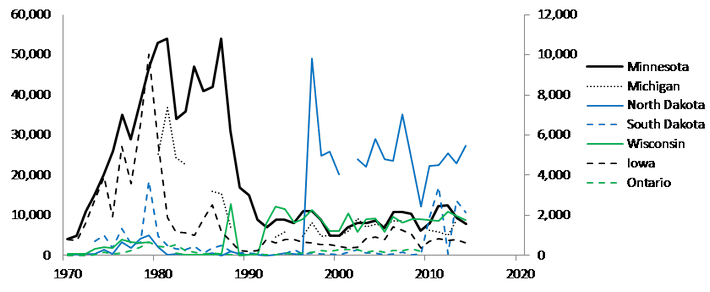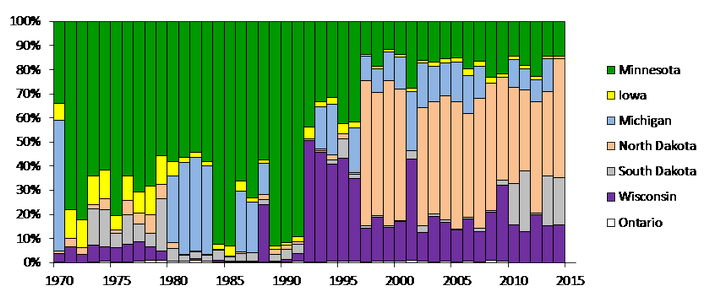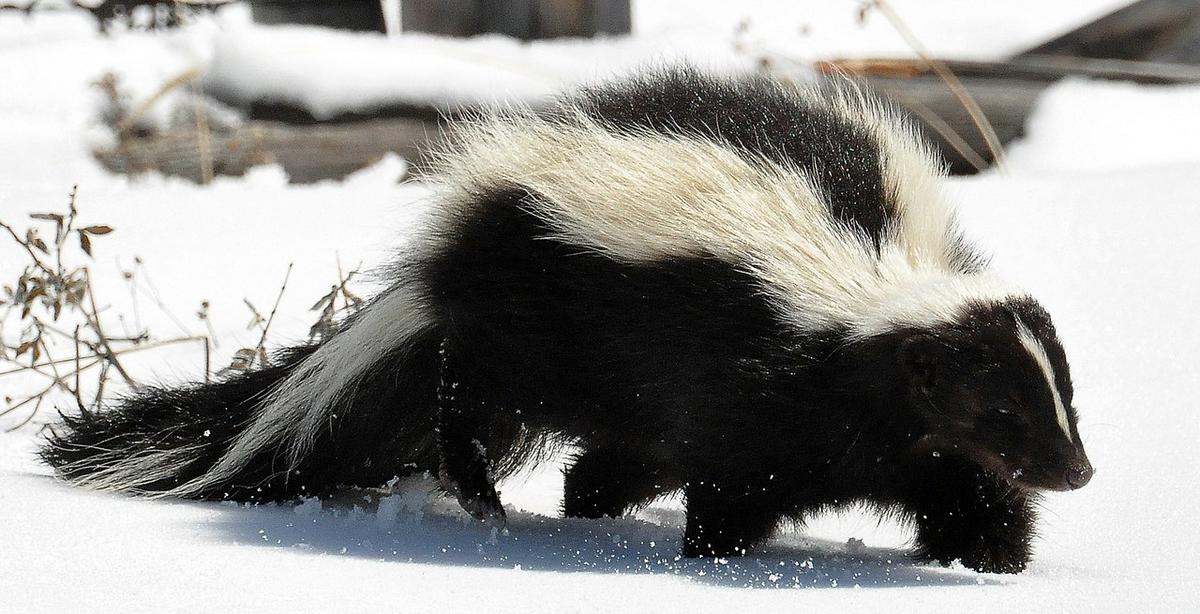
Description
Striped skunks are largely nocturnal, medium-sized omnivores in the weasel family (Mustelidae). Skunks are about the size of house cats, and have distinctive black and white fur patterns. Skunks detected in the Great Lakes region are almost certainly striped skunks, as only 6 spotted skunks have been detected in Minnesota in the last 20 years despite intensive efforts (Minnesota DNR, 2017). Spotted skunks have a more complicated pattern of spots and broken lines, while striped skunks have two white stripes running from head to tail.
Size
Measurements from Minnesota are from Hazard (1982), from Wisconsin are from Jackson (1961), and from the Eastern United States are from Hamilton and Whitaker (1998). Total length averaged 23.1” (586 mm), ranging from 17.6” to 25” (447-635 mm) in the Eastern United States, and ranged from 21.3” to 29.5” (540-750 mm) in Wisconsin. Male total length ranged from 24.8” to 29.9” (630-760 mm) in Minnesota, and female total length ranged from 21.2” to 25.6” (540-650 mm) in Minnesota. Tail length averaged 8.7” (221 mm), ranging from 6.3” to 11.4” (159-290 mm) in the Eastern United States, and ranged from 7.9” to 11.0” (200-280 mm) in Wisconsin. Male tail length ranged from 8.7” to 11.0” (220-280 mm) in Minnesota, and female tail length ranged from 7.9” to 10.4” (200-265 mm) in Minnesota. Body weight ranged from 4.0 lb to 8.8 lb (1.8-4.0 kg) in Wisconsin. Male body weight ranged from 5.5 lb to 9.9 lb (2.5-4.5 kg) in Minnesota and female body weight ranged from 4 to 9 lb (1.8-4.1 kg) in Minnesota.
Males are typically larger than females.
Distribution & Status
Striped skunks are found in a variety of habitats from southern Canada throughout the United States into northern Mexico. Skunks readily adapt to urban, suburban, and agricultural land use. Skunks can be found throughout the Great Lakes region, with populations secure in all states and Ontario.
Worldwide, Mephitis mephitis is restricted to North America. Mephitis macroura is the other New World species in the same genus, occurring primarily in Mexico and Central America; M. mephitis and M. macroura ranges overlap along a narrow strip of the U.S.-Mexico border in the southwest U.S., into northern Mexico.
Striped skunks have an IUCN rank of Least Concern, IUCN information.
Incidence in Minnesota
Striped skunks are classified as unprotected species in Minnesota. Hunting and trapping are regulated by the Minnesota Department of Natural Resources, regulations.
Population Trends
To help assess population trends, we can look at regional furbearer harvest data, methods.
Regionally, skunk harvest plummeted from peaks in the 1970s and 1980s. Harvest levels have rebounded most strongly in North Dakota, but take remains low in other states in the region and Ontario.
Until the early 1990s, Minnesota dominated regional harvest. From the late 1990s until present, North Dakota dominates regional harvest.
Life History
Striped skunks are opportunistic omnivores, with a diet that varies with what is available. Fruits, nuts, carrion, garbage, invertebrates, eggs, small mammals, amphibians, and reptiles can all be taken, but insects usually represent the majority of their diet. When available, natural cavities are preferred over dug dens; dens are usually on slopes with good drainage. Dens are usually short and shallow, a few yards long, and a yard underground. Skunk dens have 1-5 well-hidden entrances, and end in 1-3 rooms lined with vegetation. Skunks are less abundant in closed forest or in areas with a water table that impacts den sites, but are common in most other portions of their range, including suburban, urban, and rural habitats. Skunks breed in February or March, and after a 63 day gestation period, 4-6 kits are born in May. Young are born blind, with eyes opening between 2-4 weeks of age. At 2-4 weeks, kits can assume a defensive stance and discharge fluid from their scent glands. Skunk anal glands are responsible for the sulfur compounds that, when sprayed, form the pungent scent that is a skunk’s primary defense. Kits are able to follow their mother on hunting trips at two months, and soon after disperse. Skunks are prey for raptors and larger mammal carnivores.
Contacts with Humans
Skunks occasionally raid hen houses, and feed heavily on waterfowl eggs. Skunks are a major reservoir for rabies and other parasites. Skunks spray when threatened, serving as a nuisance for sprayed humans and pets. Skunks are a significant asset in controlling the populations of crop-destroying rodents and insects. Skunk fur is an important asset to the fur industry, with pelts with a greater percentage of black grading higher.
